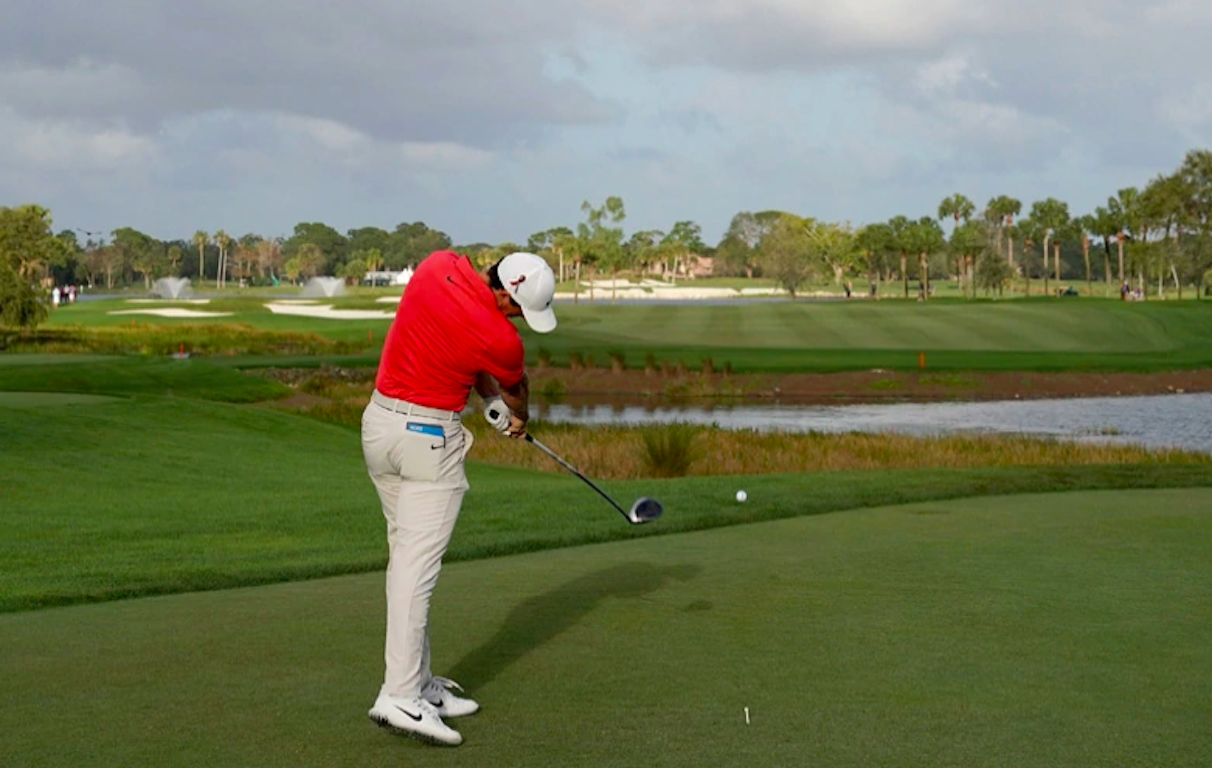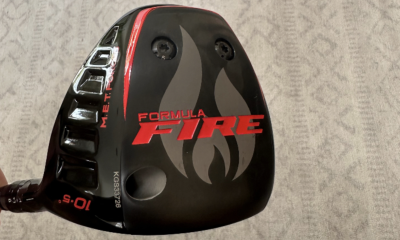Opinion & Analysis
The Wedge Guy: An examination of proper “release”

One of my favorite ‘contributions’ to this game I love is helping golfers t an “ah-ha” moment, wherein they gain an understanding of the idiosyncrasies of the golf swing that helps them make progress in their ball striking. In so many cases with recreational golfers, keys to improvement can be much more conceptual than physical. In other words, helping a golfer discover what really should be happening in various parts of the golf swing leads them to make their own swing alterations to adopt this new understanding.
I firmly believe that teaching through understanding is much more productive than trying to teach “a new move” through the physical approach. From my observation of recreational golfers, particularly those with “homemade” swings (which all have the potential to produce better and more consistent results in my opinion), one of the most misunderstood intricacies of the golf swing is how the club should be “released” through the impact zone.
Almost universally, golfers seem to think that the club releases through impact by or with an unhinging of the wrists, so that the left arm and shaft form a straight line.
If you genuinely want to improve your ball striking, your distance, your consistency and your scores, I suggest you pursue a genuine and technical understanding of this critical segment of the golf swing. Because most of you are
stuck in front of your TV right now–watching more golf than you are playing–you can make this time count. Every chance you get, watch the slow-motion videos of the golf swing from behind the golfer, looking down the line. A
straight-on view of the golf swing does not reveal this angle, but that is mostly what we are given in swing analysis by television and magazines, unfortunately.
[I’ll offer too, that you can learn a lot more from watching the LPGA players than the guys, as these very talented ladies are much closer to our own strength profiles. In my opinion, most of them are much more fundamentally
sound in their mechanics as they simply have to get the most efficiency out of the swing.]
What you will see, particularly with the wedge and short iron shots is that the hands and arms follow a path through impact that very nearly “covers” their position at address, where a distinct angle is formed by the left arm and shaft of the club…again, looking from behind the golfer down the target line.
As you study these videos and still photos, you’ll see that in the longer, more powerful swings–driver, metals, hybrids–the hands drift a little higher and away from the body more than they do with the middle and short irons, but the angle is still there. As you watch these guys hit the delicate short shots around the greens, the hands almost identically cover their address position.
That’s because a proper “release” of the club is not as much an unhinging of the wrists, but rather a rotation of the hands and arms through impact, in concert with and driven by the rotation of the body core itself. Close examination shows that the hands remain almost directly in front of the sternum through the entire impact zone, and the forearms and hands rotate – not unhinge – so that the club is squared at the ball for consistent impact.
Now, all this diagnosis would not be worth a dime to you if I didn’t show you how to experience this for yourself. Like most new physical activities, you are always best served by trying to LEARN IT IN SLOW MOTION! Simply pick up your 8- or 9-iron and find a place in your house or garage where you won’t take out a table lamp, and make very S-L-O-W swings, while concentrating on making this rotational release motion.
Your goal is to set up at address with the left arm hanging naturally from your shoulder, not pushed out toward the ball. Take the club back with a rotation of the body core, and then back through the impact zone, concentrating on making the left arm and hands exactly “cover” their address position. The angle of the wrists is maintained, and the club rotates through the ball, as your body rotates through impact.
Once you get the feel of it in slow motion, make slightly faster swings, concentrating on the path of the arms and that rotational release. When you actually hit balls with this newly-learned release–DO IT AT 35-50% POWER–you’ll be amazed at the boring trajectories and effortless distance you will get!
Let’s get some feedback on this, guys. How did you do?
- LIKE82
- LEGIT16
- WOW4
- LOL2
- IDHT1
- FLOP2
- OB1
- SHANK26
19th Hole
Vincenzi’s 2024 Zurich Classic of New Orleans betting preview

The PGA TOUR heads to New Orleans to play the 2023 Zurich Classic of New Orleans. In a welcome change from the usual stroke play, the Zurich Classic is a team event. On Thursday and Saturday, the teams play best ball, and on Friday and Sunday the teams play alternate shot.
TPC Louisiana is a par 72 that measures 7,425 yards. The course features some short par 4s and plenty of water and bunkers, which makes for a lot of exciting risk/reward scenarios for competitors. Pete Dye designed the course in 2004 specifically for the Zurich Classic, although the event didn’t make its debut until 2007 because of Hurricane Katrina.
Coming off of the Masters and a signature event in consecutive weeks, the field this week is a step down, and understandably so. Many of the world’s top players will be using this time to rest after a busy stretch.
However, there are some interesting teams this season with some stars making surprise appearances in the team event. Some notable teams include Patrick Cantlay and Xander Schauffele, Rory McIlroy and Shane Lowry, Collin Morikawa and Kurt Kitayama, Will Zalatoris and Sahith Theegala as well as a few Canadian teams, Nick Taylor and Adam Hadwin and Taylor Pendrith and Corey Conners.
Past Winners at TPC Louisiana
- 2023: Riley/Hardy (-30)
- 2022: Cantlay/Schauffele (-29)
- 2021: Leishman/Smith (-20)
- 2019: Palmer/Rahm (-26)
- 2018: Horschel/Piercy (-22)
- 2017: Blixt/Smith (-27)
2024 Zurich Classic of New Orleans Picks
Tom Hoge/Maverick McNealy +2500 (DraftKings)
Tom Hoge is coming off of a solid T18 finish at the RBC Heritage and finished T13 at last year’s Zurich Classic alongside Harris English.
This season, Hoge is having one of his best years on Tour in terms of Strokes Gained: Approach. In his last 24 rounds, the only player to top him on the category is Scottie Scheffler. Hoge has been solid on Pete Dye designs, ranking 28th in the field over his past 36 rounds.
McNealy is also having a solid season. He’s finished T6 at the Waste Management Phoenix Open and T9 at the PLAYERS Championship. He recently started working with world renowned swing coach, Butch Harmon, and its seemingly paid dividends in 2024.
Keith Mitchell/Joel Dahmen +4000 (DraftKings)
Keith Mitchell is having a fantastic season, finishing in the top-20 of five of his past seven starts on Tour. Most recently, Mitchell finished T14 at the Valero Texas Open and gained a whopping 6.0 strokes off the tee. He finished 6th at last year’s Zurich Classic.
Joel Dahmen is having a resurgent year and has been dialed in with his irons. He also has a T11 finish at the PLAYERS Championship at TPC Sawgrass which is another Pete Dye track. With Mitchell’s length and Dahmen’s ability to put it close with his short irons, the Mitchell/Dahmen combination will be dangerous this week.
Taylor Moore/Matt NeSmith +6500 (DraftKings)
Taylor Moore has quickly developed into one of the more consistent players on Tour. He’s finished in the top-20 in three of his past four starts, including a very impressive showing at The Masters, finishing T20. He’s also finished T4 at this event in consecutive seasons alongside Matt NeSmith.
NeSmith isn’t having a great 2024, but has seemed to elevate his game in this format. He finished T26 at Pete Dye’s TPC Sawgrass, which gives the 30-year-old something to build off of. NeSmith is also a great putter on Bermudagrass, which could help elevate Moore’s ball striking prowess.
- LIKE8
- LEGIT3
- WOW1
- LOL1
- IDHT0
- FLOP3
- OB1
- SHANK2
19th Hole
Vincenzi’s 2024 LIV Adelaide betting preview: Cam Smith ready for big week down under

After having four of the top twelve players on the leaderboard at The Masters, LIV Golf is set for their fifth event of the season: LIV Adelaide.
For both LIV fans and golf fans in Australia, LIV Adelaide is one of the most anticipated events of the year. With 35,000 people expected to attend each day of the tournament, the Grange Golf Club will be crawling with fans who are passionate about the sport of golf. The 12th hole, better known as “the watering hole”, is sure to have the rowdiest of the fans cheering after a long day of drinking some Leishman Lager.
The Grange Golf Club is a par-72 that measures 6,946 yards. The course features minimal resistance, as golfers went extremely low last season. In 2023, Talor Gooch shot consecutive rounds of 62 on Thursday and Friday, giving himself a gigantic cushion heading into championship Sunday. Things got tight for a while, but in the end, the Oklahoma State product was able to hold off The Crushers’ Anirban Lahiri for a three-shot victory.
The Four Aces won the team competition with the Range Goats finishing second.
*All Images Courtesy of LIV Golf*
Past Winners at LIV Adelaide
- 2023: Talor Gooch (-19)
Stat Leaders Through LIV Miami
Green in Regulation
- Richard Bland
- Jon Rahm
- Paul Casey
Fairways Hit
- Abraham Ancer
- Graeme McDowell
- Henrik Stenson
Driving Distance
- Bryson DeChambeau
- Joaquin Niemann
- Dean Burmester
Putting
- Cameron Smith
- Louis Oosthuizen
- Matt Jones
2024 LIV Adelaide Picks
Cameron Smith +1400 (DraftKings)
When I pulled up the odds for LIV Adelaide, I was more than a little surprised to see multiple golfers listed ahead of Cameron Smith on the betting board. A few starts ago, Cam finished runner-up at LIV Hong Kong, which is a golf course that absolutely suits his eye. Augusta National in another course that Smith could roll out of bed and finish in the top-ten at, and he did so two weeks ago at The Masters, finishing T6.
At Augusta, he gained strokes on the field on approach, off the tee (slightly), and of course, around the green and putting. Smith able to get in the mix at a major championship despite coming into the week feeling under the weather tells me that his game is once again rounding into form.
The Grange Golf Club is another course that undoubtedly suits the Australian. Smith is obviously incredibly comfortable playing in front of the Aussie faithful and has won three Australian PGA Championship’s. The course is very short and will allow Smith to play conservative off the tee, mitigating his most glaring weakness. With birdies available all over the golf course, there’s a chance the event turns into a putting contest, and there’s no one on the planet I’d rather have in one of those than Cam Smith.

Louis Oosthuizen +2200 (DraftKings)
Louis Oosthuizen has simply been one of the best players on LIV in the 2024 seas0n. The South African has finished in the top-10 on the LIV leaderboard in three of his five starts, with his best coming in Jeddah, where he finished T2. Perhaps more impressively, Oosthuizen finished T7 at LIV Miami, which took place at Doral’s “Blue Monster”, an absolutely massive golf course. Given that Louis is on the shorter side in terms of distance off the tee, his ability to play well in Miami shows how dialed he is with the irons this season.
In addition to the LIV finishes, Oosthuizen won back-to-back starts on the DP World Tour in December at the Alfred Dunhill Championship and the Mauritus Open. He also finished runner-up at the end of February in the International Series Oman. The 41-year-old has been one of the most consistent performers of 2024, regardless of tour.
For the season, Louis ranks 4th on LIV in birdies made, T9 in fairways hit and first in putting. He ranks 32nd in driving distance, but that won’t be an issue at this short course. Last season, he finished T11 at the event, but was in decent position going into the final round but fell back after shooting 70 while the rest of the field went low. This season, Oosthuizen comes into the event in peak form, and the course should be a perfect fit for his smooth swing and hot putter this week.

- LIKE13
- LEGIT3
- WOW1
- LOL1
- IDHT0
- FLOP1
- OB1
- SHANK1
Opinion & Analysis
The Wedge Guy: What really makes a wedge work? Part 1

Of all the clubs in our bags, wedges are almost always the simplest in construction and, therefore, the easiest to analyze what might make one work differently from another if you know what to look for.
Wedges are a lot less mysterious than drivers, of course, as the major brands are working with a lot of “pixie dust” inside these modern marvels. That’s carrying over more to irons now, with so many new models featuring internal multi-material technologies, and almost all of them having a “badge” or insert in the back to allow more complex graphics while hiding the actual distribution of mass.
But when it comes to wedges, most on the market today are still single pieces of molded steel, either cast or forged into that shape. So, if you look closely at where the mass is distributed, it’s pretty clear how that wedge is going to perform.
To start, because of their wider soles, the majority of the mass of almost any wedge is along the bottom third of the clubhead. So, the best wedge shots are always those hit between the 2nd and 5th grooves so that more mass is directly behind that impact. Elite tour professionals practice incessantly to learn to do that consistently, wearing out a spot about the size of a penny right there. If impact moves higher than that, the face is dramatically thinner, so smash factor is compromised significantly, which reduces the overall distance the ball will fly.
Every one of us, tour players included, knows that maddening shot that we feel a bit high on the face and it doesn’t go anywhere, it’s not your fault.
If your wedges show a wear pattern the size of a silver dollar, and centered above the 3rd or 4th groove, you are not getting anywhere near the same performance from shot to shot. Robot testing proves impact even two to three grooves higher in the face can cause distance loss of up to 35 to 55 feet with modern ‘tour design’ wedges.
In addition, as impact moves above the center of mass, the golf club principle of gear effect causes the ball to fly higher with less spin. Think of modern drivers for a minute. The “holy grail” of driving is high launch and low spin, and the driver engineers are pulling out all stops to get the mass as low in the clubhead as possible to optimize this combination.
Where is all the mass in your wedges? Low. So, disregarding the higher lofts, wedges “want” to launch the ball high with low spin – exactly the opposite of what good wedge play requires penetrating ball flight with high spin.
While almost all major brand wedges have begun putting a tiny bit more thickness in the top portion of the clubhead, conventional and modern ‘tour design’ wedges perform pretty much like they always have. Elite players learn to hit those crisp, spinny penetrating wedge shots by spending lots of practice time learning to consistently make contact low in the face.
So, what about grooves and face texture?
Grooves on any club can only do so much, and no one has any material advantage here. The USGA tightly defines what we manufacturers can do with grooves and face texture, and modern manufacturing techniques allow all of us to push those limits ever closer. And we all do. End of story.
Then there’s the topic of bounce and grinds, the most complex and confusing part of the wedge formula. Many top brands offer a complex array of sole configurations, all of them admittedly specialized to a particular kind of lie or turf conditions, and/or a particular divot pattern.
But if you don’t play the same turf all the time, and make the same size divot on every swing, how would you ever figure this out?
The only way is to take any wedge you are considering and play it a few rounds, hitting all the shots you face and observing the results. There’s simply no other way.
So, hopefully this will inspire a lively conversation in our comments section, and I’ll chime in to answer any questions you might have.
And next week, I’ll dive into the rest of the wedge formula. Yes, shafts, grips and specifications are essential, too.
- LIKE36
- LEGIT7
- WOW1
- LOL1
- IDHT2
- FLOP3
- OB1
- SHANK3
-

 19th Hole3 weeks ago
19th Hole3 weeks agoDave Portnoy places monstrous outright bet for the 2024 Masters
-

 19th Hole1 week ago
19th Hole1 week agoJustin Thomas on the equipment choice of Scottie Scheffler that he thinks is ‘weird’
-

 19th Hole3 weeks ago
19th Hole3 weeks agoTiger Woods arrives at 2024 Masters equipped with a putter that may surprise you
-

 19th Hole1 week ago
19th Hole1 week ago‘Absolutely crazy’ – Major champ lays into Patrick Cantlay over his decision on final hole of RBC Heritage
-

 19th Hole2 weeks ago
19th Hole2 weeks agoTwo star names reportedly blanked Jon Rahm all week at the Masters
-

 19th Hole2 weeks ago
19th Hole2 weeks agoReport: LIV Golf identifies latest star name they hope to sign to breakaway tour
-

 19th Hole2 weeks ago
19th Hole2 weeks agoNeal Shipley presser ends in awkward fashion after reporter claims Tiger handed him note on 8th fairway
-

 19th Hole2 weeks ago
19th Hole2 weeks agoBrandel Chamblee has ‘no doubt’ who started the McIlroy/LIV rumor and why
























Ray Bennett
Feb 19, 2020 at 4:45 pm
Reads like an open to shut release or a knuckle over through impact. This release doesn’t match up well with a core or spine driven swing because there are too many closing elements present during the strike. A better match is a square to square or a a shut to open release where the clubface is square or shut to the swing plane immediately before impact and remains square or opens past the divot (left palm up to left palm down through the release with a neutral grip).
Ed LeBeau
Feb 19, 2020 at 10:57 am
I think I agree with Terry but I think the term “release” carries a lot of baggage. To experience what he is describing, here is a drill you can do. 1) insert about a half inch of a long tee into the hole in the butt end of a grip, 2)set up at address, 3)observe the relationship of the tee to your leading forearm [its probably an inch or so from the forearm], 4) assume the shaft at address is 6 o’clock, s l o w l y make a backswing to 7 o’clock while carefully maintaining the tee’s relationship to your left forearm. 5) do the same now from 7 o’clock to 8 o’clock, 6) now reverse this and make the forward swing s l o w l y from 8 to 7 to 6 to 5 to 4, 7) what you will see is that your body and club are in the same position as in the photo in Terry’s article.
By maintaining the tee’s position relative to your forearm you are in fact maintaining the club’s relationship to you. The club stays in front of you and as you turn the club turns with you. As your body rotates through the ball the club does as well and arrives square to the target line producing the ball flight Terry describes.
Drew
Feb 19, 2020 at 2:42 am
This doesn’t make much sense to me either. “Covering” the ball is a term I’ve heard before but I’m convinced it only makes sense until after you’ve learned how to do it. It’s not an action you can teach players to do by just saying the word “cover!”. No idea at all what you’re talking about in this article, unfortunately. It’s amazing how much poorly written golf instruction is out there. Try not to be a part of it!
freowho
Feb 18, 2020 at 11:50 pm
Could not disagree with this more.
Pause the video below at 1:49min.
https://www.youtube.com/watch?v=ln-3D-NxH0E
Blixt is trying to keep his arms extended. Snead is trying to fold them as much as possible. You shouldn’t be trying to replicate impact. It occurs because of momentum from folding the arms back to folding the arms through while spinning with the legs. What you see at impact is not what the greats were trying to do.
Luke Keefner
Feb 18, 2020 at 8:07 pm
Jason dufners waggle seems like a great preparatory practice drill for the feeling of a correct release. Check out Mike Malaska’s videos on YouTube. I’ve been working on this all winter in the living room. Come on spring!!!
RayRise
Feb 19, 2020 at 11:20 am
Two important points you make Luke – Dufner does indeed waggle his line away and to the ball in a relaxed manner and I also find Malaska is an exceptional. I too can’t wait for the rain and cold to end in UK.
Kyle Leskiw
Feb 18, 2020 at 7:23 pm
Extending the club shaft up your lead arm with an alignment stick to prevent the wrists from flipping is probably a better way to explain this ????
Tour Player (retired)
Feb 18, 2020 at 2:33 pm
Amateur golfers are notoriously arm swingers…and higher handicap amateurs also attempt to use their hands and wrists. Whereas the golf swing of professionals and scratch golfers is initiated from the center of the body – the unwinding rotation of their torso or their shoulders, not from any intentional use of their arms. Your shoulders are like the middle of a merry-go-round – they don’t have to spin very fast in order for there to be tremendous forces at play that you can’t overcome. When you can learn to lead the downswing with either the torso or the shoulders unwinding that in-turn bring the (lagging behind) arms and clubs with that unwinding motion you’ll see results like never before. Trying to intentionally pull the lead arm down causes you to stall the shoulders, early extension, over-the-top and lack of clubhead speed. The arms, wrists/hands should be passive to the motor unwinding of the shoulders or torso. It’s a matter of changing your intentions because our golf swings reflect what we believe, and that’s where our incorrect concepts get us into trouble. The release happens naturally when your swing is driven from the unwinding of your torso or shoulders.
Pete S
Feb 18, 2020 at 1:57 pm
This would be much easier to follow if there were pictures or video included.
Jack
Feb 18, 2020 at 8:59 pm
That’s exactly what I was thinking.
Jim T
Feb 19, 2020 at 11:53 am
Likewise
Cam
Feb 20, 2020 at 12:10 am
Yes! Diagrams or something to explain the angles you’re referring to!